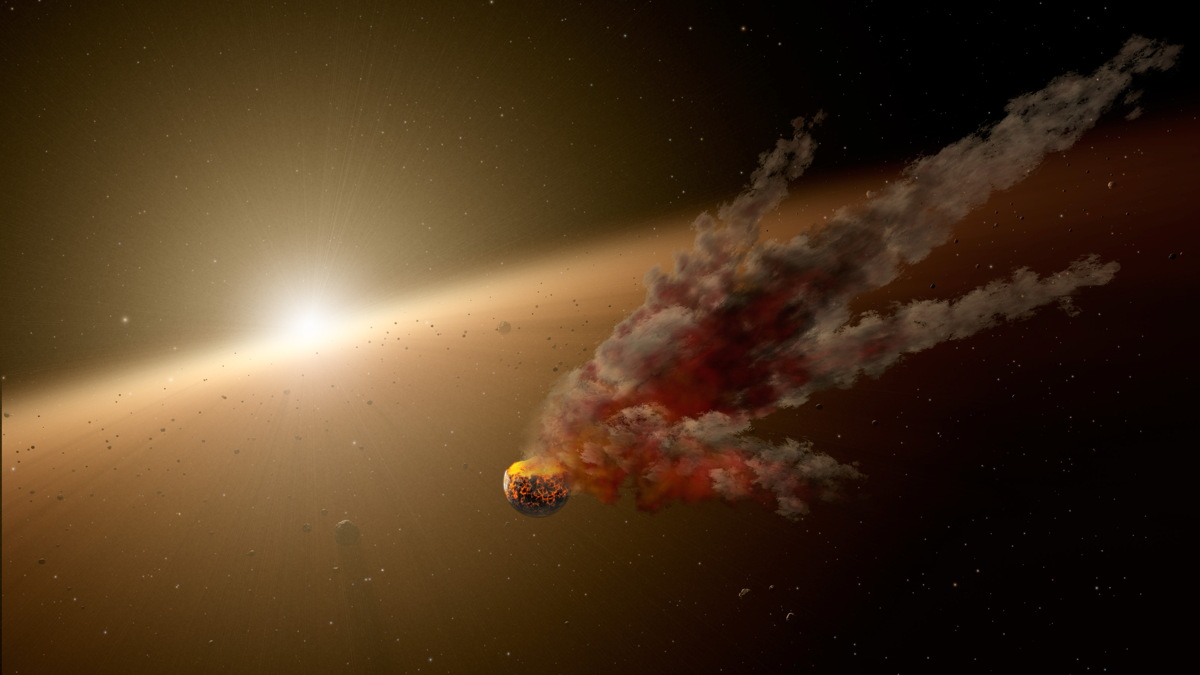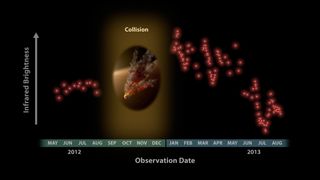
Astronomers have spotted the wreckage of a mammoth collision around a distant young star, a landmark find that could shed light on how our own solar system's rocky planets took shape long ago.
The researchers detected a huge disk of dusty debris around a sunlike star called NGC-2547 ID8, which lies about 1,140 light-years from Earth in the constellation Vela. The cloud was likely spawned when two planetary building blocks slammed into each other just two years ago or so, scientists said.
"This is the first detection of a planetary impact outside of our own solar system," study lead author Huan Meng, of the University of Arizona in Tucson, told Space.com. [Moon Made by Giant Impact with Earth: New Evidence (Video)]
Further, NGC-2547 ID8 is the same mass and size as our sun, and it's just 35 million years old — the same age the sun was when similar impacts were building Earth, Mars and the other rocky planets in our neck of the cosmic woods.
"This discovery really puts our own solar system into context," Meng said.
Flaring up and fading away
Meng and his colleagues studied NGC-2547 ID8 using NASA's Spitzer Space Telescope and several different ground-based instruments. They watched the star from May 2012 to August 2013, with a hiatus from mid-August 2012 to January 2013, when the object was too close to the sun to be observed.
When NGC-2547 ID8 came back into view in January 2013, Spitzer measured a dramatic flare-up of infrared light indicative of emission from small dust particles. This outburst faded rapidly over the remainder of the observing period.
Get the Space.com Newsletter
Breaking space news, the latest updates on rocket launches, skywatching events and more!
Computer modeling work suggested that the surge was caused by the impact of two big, rocky objects —large asteroids or protoplanets, the progenitors of full-fledged rocky worlds such as Earth, in the "terrestrial planet zone" of the NGC-2547 ID8 system. (Gas giants like Saturn form farther out and at a slightly earlier stage of a star's life.)
The collision probably occurred during or slightly before the 2012-13 observing gap, Meng said. It generated a mammoth cloud of vapor that condensed into small silicate spherules, which were in turn broken down into dust by subsequent collisions among themselves. These dust particles are so small that they were quickly expelled from the NGC-2547 ID8 system by stellar radiation pressure, explaining why the infrared spike was so short-lived.
Meng and his colleagues are confident that this interpretation of the surprising flare-up is the correct one.
"I can't imagine something else that could produce so much dust just within four months," Meng said.
Astronomers have seen debris disks around other stars before, but those disks have primarily been stable structures akin to the asteroid belt, he added.
"This is the first time that we really see a debris disk vary," Meng said. "The implication is that we are witnessing the immediate aftermath of a huge impact."
Such impacts can be destructive or constructive, researchers say. Sometimes the objects obliterate each other, as may be the case with the NGC-2547 ID8 crash, and sometimes they glom together to build something bigger.

Solving a puzzle
Observations by NASA's Kepler spacecraft suggest that rocky planets are common throughout the Milky Way galaxy. Why, then, have astronomers not spotted many debris disks like the one surrounding NGC-2547 ID8?
The new study, which was published online today (Aug. 28) in the journal Science, suggests an answer: The disks disappear surprisingly rapidly, so you have to be pretty lucky, or pretty persistent, to spot one.
Without any replenishment from secondary impacts, "this dust will fade over one or two years," Meng said. "That's really quick."
Follow Mike Wall on Twitter @michaeldwall and Google+. Follow us @Spacedotcom, Facebook or Google+. Originally published on Space.com.
Join our Space Forums to keep talking space on the latest missions, night sky and more! And if you have a news tip, correction or comment, let us know at: community@space.com.

Michael Wall is a Senior Space Writer with Space.com and joined the team in 2010. He primarily covers exoplanets, spaceflight and military space, but has been known to dabble in the space art beat. His book about the search for alien life, "Out There," was published on Nov. 13, 2018. Before becoming a science writer, Michael worked as a herpetologist and wildlife biologist. He has a Ph.D. in evolutionary biology from the University of Sydney, Australia, a bachelor's degree from the University of Arizona, and a graduate certificate in science writing from the University of California, Santa Cruz. To find out what his latest project is, you can follow Michael on Twitter.